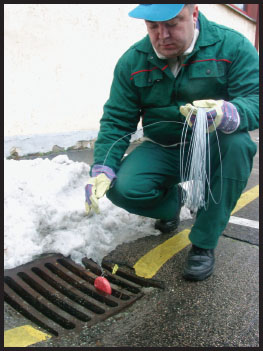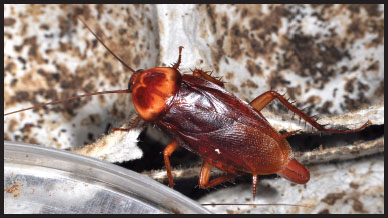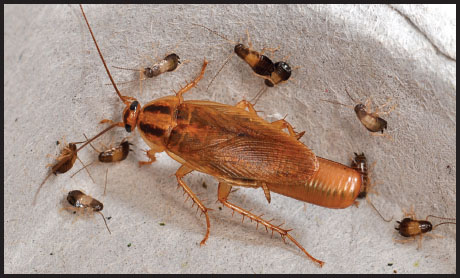Feral Cities (22 page)
Authors: Tristan Donovan

A twig covered in sap-sucking scale insects, which thrive in the hottest parts of Raleigh, North Carolina.
MATT BERTONE

Keeping Budapest rat-free: a Bábolna Bio employee laying poison.
COURTESY OF BÃBOLNA BIO

American cockroaches might look all the same to us, but there is a big genetic gulf between those found in different parts of New York City.
MATT BERTONE

The German cockroach, the Big Apple's most abundant roach.
MATT BERTONE

Hanging Out with the Parrots of Brooklyn
Just a short walk from Twenty-Fifth Street station in Brooklyn lies the grand archway that marks the entrance to Green-Wood Cemetery. In the 1860s this sprawling burial ground was the second-most-popular tourist attraction in the United States, and every year half a million people would pass through its ornate, brownstone arches. Only Niagara Falls was more visited.
Green-Wood's gothic archway was new then, but it's still a majestic sight. At its center is a tall clock tower topped with an elongated spire decorated with floral sculptures that run up the edges of its pyramidal structure. On either side are two shorter towers with similar spires connected to the clock tower with elaborate flying buttresses. Beneath the buttresses are the entranceway's two arches, each complemented by biblical relief sculptures with titles like “Weep Not” and “The Dead Shall Be Raised.”
There's something else, too, right at the base of the clock tower spire: a tightly woven clump of twigs packed into the crevices and punctured with large, smooth holes. And that's where the Brooklyn parrots live.
I missed it at first, too focused on the intricate architecture to see the huge monk parakeet nest crowning the spire. It took Steve Baldwin, founder of the Brooklyn Parrot Society who has offered to introduce me to the borough's parakeets, to bring it to my attention. “See those holes?” he says. “Each portal represents an individual nesting cavity for at least one pair of monk parakeets. The portals normally have two birds, but for those who bore young this year, there will be three.”
Monk parakeets are deft engineers. “There are little flowers in the nest that provide inside support, and the monks use that to support some of the weight of the nest,” says Steve. “Then, they keep building out from that and the nest is so densely woven that it gets this shape that belongs in the space and is very difficult to dislodge.”
So difficult to dislodge that when Hurricane Sandy hit in 2012, the parakeet nest came out the other side unscathed. “They always choose live twigs that are flexible. They don't use dry timber. They take the twigs straight off the trees, fly them over to the nest, and stick them in. Or they hand them to another bird that will work them carefully into the nest expansion area. They are very systematic.”
We count the holes in the nest. It's hard to make an accurate count from the ground, but Steve reckons there are fourteen nest holes. Fourteen holes, twenty-eight parrots at least, but probably more. “If there are babies it may be more like thirty-five, thirty-six,” he says.
He has counted as many as seventy-five parrots here in the past. “What seems to happen is the flocks build to a certain size, about seventy-five birds, and then something happens and when you next show up it's like half the flock. It's like half splits off and goes somewhere else. Then it takes the rest five to ten years to reach that level of seventy-five and then it splits off again. I think that is what is going on, although it's just suspicion.”
None of the bright green birds are around, however. The nest is quiet and still. The birds are out feeding somewhere. “Typically
they take off in the morning,” says Steve. “They are small but they fly a long way. They can fly twenty miles.”
The nest on the archway is the main monk parakeet nest in Green-Wood, but there are others dotted around the vast, hilly cemetery with its impressive views over Manhattan.
As we head into the cemetery Steve tells me how it is thought the parakeets got to Brooklyn in the first place. Before 1993, when the United States banned the import of parrots, monk parakeets were a big deal in the pet trade and Argentina exported them by the thousands. “They were trying to get rid of the parrots because they were pests in Argentina. At first they tried to shoot them, but there was fraud in the program, so they started capturing them in the areas where they were damaging crops and started making money from them as an export crop. Caged birds were popular at the time, and monk parakeets are a very good cage bird. They are the second-best talking parrot and they have all of the attractive, charismatic qualities, but they are also small so you don't have to have a giant cage.”
There are two leading theories for how they got free, both of which implicate John F. Kennedy International Airport. The airport is only fifteen miles east of Green-Wood and used to be a major entry point for Argentina's exported parrots. The first theory is that the birds broke out of JFK's quarantine station. “When exotic birds were still coming into the country, they would take the birds into quarantine and keep them there for thirty days to see if they showed signs of Newcastle disease,” says Steve. “There may have been an accident at the quarantine station, maybe when attempting to transfer them from one area to another. These parrots are notorious lock pickers, so they can pick the lock on a cage and might have gotten into an air vent and then out.” That similar quarantine escapes appear to have happened in San Francisco and Chicago adds weight to the theory.
The alternative suggestion is that Brooklyn's parrots had help from organized crime. “In the 1960s the airport shipping was
infiltrated by the mob and they opened up a lot of things so they could pilfer what was in there. It's possible that a crate of parakeets got pilfered one day and the parrots just flew away and there was no record of it. That was told to me by someone who claims her brother worked at the airport at the time, but I can't verify it.”
Add to that further releases by people who no longer wanted their pet parakeets, and you've got enough for a breeding population, and with Green-Wood standing out as a prime expanse of greenery in the dense streets of Brooklyn, it makes sense that the birds gathered there.
After wandering through the cemetery for a while, we spy some parakeets. But they are not inside the cemetery. They are across the road, inside a Con Edison electricity substation, where they are busy enhancing the nests they've built on the steel girders and insulator posts. “The parrots love to hang out over there,” says Steve, as we watch them through the cemetery gates. “They do tend to prefer manmade structures to trees, and these kind of infrastructures with lots of angles give them a great substructure to build nests on. They really obsess about the quality of their nests.”
The parakeets are certainly hard at work. They fly in with twigs held in their orange bills and weave them into their nests before flying out to collect more. One is making adjustments while hanging upside down from a girder, revealing the pale gray breast of its underside. The only breaks they take are to drink from a pool of rainwater that has formed on the flat roof of one of the substation buildings. They remind me of the industrious Doozers from the Jim Henson TV series
Fraggle Rock,
creatures totally absorbed in never-ending construction work.
“Con Edison don't seem to mind that they are here or, at least, I don't think they mind because these nests have been here for many years and nothing's ever been done about them,” says Steve. “Maybe that's because to get the nests down they would have to shut down the power to the entire borough and they would have a
hard time explaining that. But I don't think they pose a fire hazard. Those insulators get warm, but they don't get hot.”
Power companies aren't always this easygoing with monk parakeets, which seem to be drawn to substations and power lines for the extra warmth and because the height offers them unobstructed views that make it easy to spot predators. “There have been culls,” says Steve. “There was a cull in Connecticut a few years ago, where they brought in the US Department of Agriculture and killed about 250 of them. The power company was getting very impatient with the parrots because they were removing nests from power poles and the parrots would simply rebuild their nests.”
The cull sparked protests, and Steve was among those who rushed to the parrots' aid. “Ultimately, they stopped the cull. Myself and others like me came in and created a lot of headaches for them public relations-wise. The newspapers were writing about this utility company for the first time in, like, twenty years and it was all bad, all about how cruel they were. Nobody wants to be labeled as cruel to animals. I think we Americans can be very, very violent and mean, but when it comes to animals we're very softhearted. Even the very miserly people who wouldn't even give another human being a dime.”
Steve, whose interest in parrots started with the African grey parrot he had as a teenager, tells me that he sees himself as a one-man public relations bureau for the birds. “They have such a bad reputation,” he says. “People say they are an invasive species and are endangering the lives of people who depend on electricity and that without electricity we would all be savages within a week, so the parrots should be stopped. But knowing what I know about parrots, I knew that while they may be mischievous, they are not like saboteurs or evil. That's why I love Green-Wood because they said, âWe like the parrots, we don't care if they don't belong here. They are here now and they are keeping the pigeons away, so they are doing good work.'”
The monk parakeets, he says, are very much like Americans. “That's something I try to relate to people on the tours I do. Most people who were born in America, their ancestors did not come to America because they wanted to but because they were being kicked out of their own countries, and the parrots had that happen to them. So there's an affinity there.”
The birds are very much like the New Yorkers on the streets below them too, he adds. “They talk, they build these crazy structuresâit's like performance art or somethingâand they are outrageously green. That's like a New York thing. You're fabulous! You're outrageous! And you're wearing green when everyone else is wearing brown.”